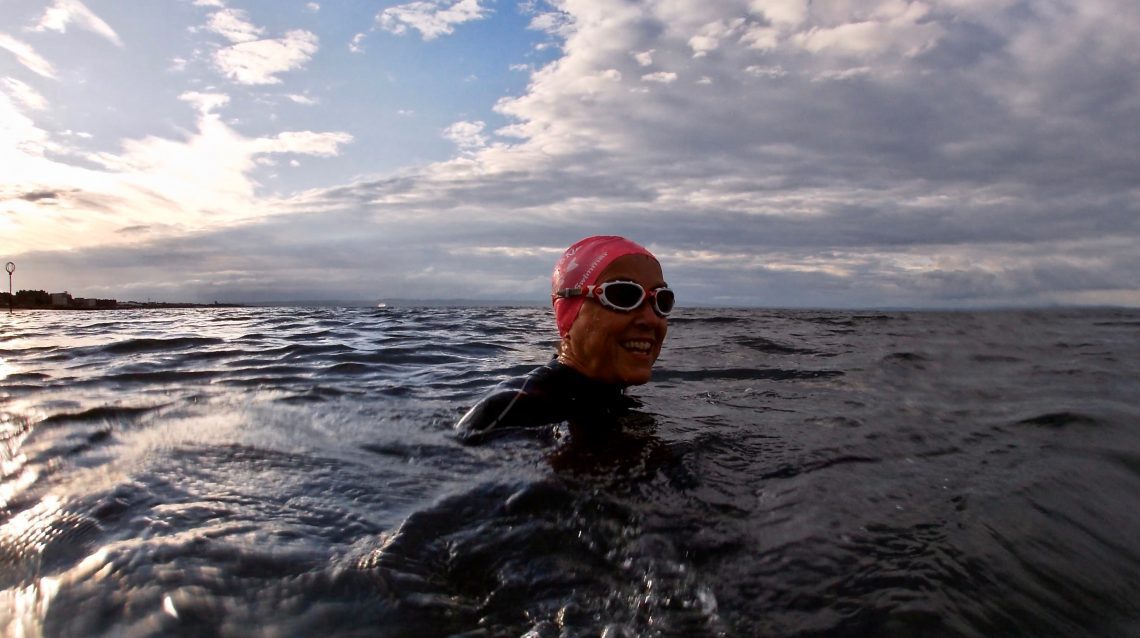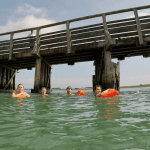
Why do we have to keep defending the safety of swimming?
You probably noticed the news last week that Brighton Council will be taking steps this year to discourage people from plunging into the sea on Christmas Day. This was followed by a widely shared (at least in open water swimming circles) article from the BBC on How Dangerous is Sea Swimming in Cold Weather?
The article didn’t really answer its own question but concluded that: “No activity is completely risk free – there’s always a balance to be reached.” Exactly.
But why are we, as outdoor swimmers, so frequently quizzed over the safety of our hobby? Is it so outrageously dangerous that our life assurance policies should be annulled? Are we crazy adrenaline junkies?
Open water swimming “enjoys” a reputation for risk and danger that far exceeds the reality. It might help give open water swimmers a bit of street credibility (of the “I can’t believe you did that” type) but it’s also extremely tiresome. Relatively speaking, open water swimming is not a dangerous activity. I hope this doesn’t disappoint anyone.
Last week we tweeted a question asking readers what other sports they do. Cycling was a popular response. I enjoy cycling too. I don’t cycle as much as I swim but I’ve had many more accidents. I’ve been knocked over my handlebars by someone opening a car door in my face; I’ve been brought down by a jogger who was looking the wrong way while crossing the road; I’ve lost my wheels on ice and wet leaves; I’ve tried to go around corners too fast and ended up in hedges and ditches and (probably the most embarrassing one) I’ve fallen off (more than once) when I’ve failed to disengage my feet from my pedals. Luckily none of the above has resulted in anything worse than cuts, bruises and a damaged ego – although any of them could have been much more harmful.
After swimming myself into hospital with hypothermia I can’t claim that I’ve never done myself any harm in the water. Other injuries include a grazed stomach from diving onto rocks (a long time ago – youthful stupidity), ripped nails from lane ropes and a sore head from a collision with someone swimming the wrong way – and the latter two were both in the pool. Admittedly diving onto rocks could have resulted in a lot more damage but as it was totally preventable I don’t really class it as an accident.
But this is just anecdotal evidence. To properly compare the risks and dangers you need to look at some statistics and luckily we have some from the Royal Society for the Prevention of Accidents in their report: “Assessing Inland Accidental Drowning Risk”. Note that this concerns inland waters and therefore doesn’t cover sea swimming, but we’ll get to that separately.
According to the report, outdoor swimming in inland waters has a death rate of 1 per 120,000 participants per year. Compare this to boating (manually powered) – 1 death per 60,000 participants; angling – 1 death per 56,000; and power boating – 1 death per 21,000. So outdoor swimming is relatively safe compared with other sports on or near water. Only wind and kite surfing are safer at 1 death per 310,000.
Usefully the report also gives the death rates for cycling (1 per 12,000) and driving (1 per 55,000). So outdoor swimming (in inland waters) is approximately twice as safe as driving (or being a passenger in a car) and 10 times safer than cycling*.
So why is open water swimming perceived to be so dangerous?
Two things, I think. Firstly, the comparison to indoor swimming. As the report notes: “Swimming indoors has a very low rate of death, and would be defined as negligible.” In 2013 there were four deaths from swimming pool drownings.
The death rate from indoor swimming is about 1 per 3,300,000 making it almost 30 times safer than outdoor swimming. Outdoor swimming is unquestionably more dangerous than indoor swimming.
Secondly, the binary nature of outcomes from incidents colours people’s assessment of the risk. A bit like flying, although the risk of something going wrong is small, if it does the consequences are bad. With outdoor swimming, drowning usually means death. With cycling in contrast you see a wide spectrum for outcomes from incidents such as bruises, road rash to broken limbs and worse. The working assumption is then that if something goes wrong it will result in an injury rather than death, although death is still more likely than for swimming. You don’t hear about people getting injured swimming (apart from some spinal chord injuries from diving), you hear about them dying. Drowning deaths frequently make the national news (because they are relatively uncommon) whereas driving and cycling deaths go unremarked.
An additional possibility is that it suits the owners and managers of lakes, reservoirs and rivers to talk up the dangers to discourage swimming and hence reduce their liability risk.
Turning back briefly to the sea, and taking figures from a different report (the Water Incident Database (WAID) published by the National Water Safety Forum), we see there were 59 swimming related deaths in 2013 in England, Scotland and Wales out of a total of 381 water related deaths. Of those 59, 20 occurred at beaches or at the coast and two in harbours. This means 33 occurred in inland waters.
What we don’t know here are the relative number of participants but the likelihood is that there are many more sea swimmers than inland water swimmers but effective action by beach lifeguards keeps the number of incidents low.
The best way to talk about risk is in relative not absolute terms. We can’t say outdoor swimming is safe. We can say it’s safer than driving a car, riding a bike and fishing. You’re more likely to die getting to your swim than doing it, and while swimming you’re safer than the guy sitting on the bank glaring at you because you’re scaring away his fish.
This doesn’t now mean that you can swim with impunity and all the usual warnings still apply but hopefully this puts the risks into perspective.
*Note: I don’t know whether these figures are adjusted for participation hours so sweeping statements about being “twice as dangerous” should be treated with a little caution.







